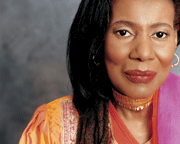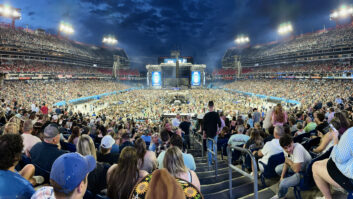
Ravi Coltrane, son of legendary saxophonist John Coltrane and keyboardist/harpist Alice Coltrane, held on to a dream for nearly 25 years — to collaborate and make a recording with his mother. A classically trained keyboardist, Alice Coltrane had already been in numerous ensembles and recorded many jazz albums before her marriage to John Coltrane in 1965. She played piano in John Coltrane’s group following the departure of McCoy Tyner, and after the sax titan’s death in 1967, she continued in her mate’s footsteps, working with both avant-garde and mainstream jazz musicians, creating her own unique brand of spiritually driven music. In the ’70s, she enjoyed her greatest solo successes, including her radiant collaboration with Carlos Santana, Illuminations. In 1978, however, Alice Coltrane withdrew from the music world, devoting her time instead to her family, her own inner development and the Vedantic Center she founded in 1975. While she was dropping out, however, her son Ravi was becoming interested in playing music.
“I was a kid and she was an accomplished musician,” Ravi Coltrane says by telephone from Elmau, Germany, while touring with his quartet. “When I decided to get involved with music, she helped me out and showed me things to use for the marching band and the little things I was doing, but by the time I really started studying music, getting into jazz and becoming a semi-professional musician, she was starting to leave [music]. She had finished professional recording and didn’t want to go on the road anymore. But she was my mom and raised me, so we had a lot of opportunities to play together.”
Unfortunately, the general public was never privy to any of those jams, except during the yearly John Coltrane Festival in Los Angeles. The annual fundraising event typically features them together, along with brother Oran (saxophone/guitar) and sister Michelle (vocals). Young scholarship winners and guest artists are also highlighted. In 2004, the Branford Marsalis Quartet headlined; long a Coltrane admirer, Marsalis has even been performing John Coltrane’s masterwork, “Love Supreme,” in recent years.
But it was two other gigs that started the momentum for the Coltranes’ eventual collaboration on the incandescent new album, Translinear Light: One was at Joe’s Pub in New York City, the other at Catalina’s in L.A. Both times, Alice Coltrane sat in with Ravi Coltrane’s quartet and enthralled audiences with her wide-open approach to playing and dynamic solos. Ravi Coltrane recalls later saying to her, “Ma, I know you can still play and you enjoy it. Let’s just make a record.”
“I felt for myself that I didn’t want her to leave this world without me feeling I had made a strong document of music with her,” Ravi Coltrane continues. “That was really the goal for me. And the other idea I had was not to make a retro-sounding Alice Coltrane record. But I didn’t want it to be completely out of my mother’s element either, and be like a hip hop or rap thing all of a sudden. That wouldn’t really translate to anyone familiar with her music. So I wanted the record to have a connection to her past, but still be more forward-looking. The choice of the players had a lot to do with that.” Besides sons Ravi and Oran, the disc features appearances by bassist Charlie Haden and drummers Jeff “Tain” Watts (of Branford Marsalis’ band) and Jack DeJohnette. The pieces chosen for the album are a combination of newly created originals, a pair of John Coltrane compositions and traditional spirituals.
The initial recording was a shared project between Ravi Coltrane and his mother. It began in April 2000 at Ocean Way Studios in Santa Monica, Calif., with Haden and DeJohnette rounding out a quartet, and Tom Mark engineering. After cutting three tracks, however, the project hit a major roadblock when Ravi Coltrane’s contract with BMG fell through. Toward the end of 2002, however, Verve/Impulse became interested in the project and spent much of the next year negotiating the contractual details. When everything was agreed upon and finalized, Alice Coltrane became the headliner, with Ravi Coltrane in the role of producer and musical contributor. He insists that was fine with him — he was just happy to get another opportunity to bring his dream to fruition.
For the second leg of Translinear Light, the Coltranes picked up where they left off, but this time at Capitol Studio B in Hollywood during February 2004 for a grueling day-long session. In April, the scene shifted to O’Henry’s in Burbank, Calif., with bassist James Genus and Watts as the rhythm section. Steve Genewick, who’s worked on many jazz projects and rock/pop recordings, handled the engineering for the 2004 sessions and the final mix. Additionally, Oran Coltrane recorded a duet with his mother at his home-based Shivani Studios in Woodland Hills, Calif., with Sam Story engineering and Vishnu Jones at the Vedantic Center recorded the Coltrane matriarch playing organ with the Sai Anantam Ashram Singers.
“At Capitol, it was a challenge,” Ravi Coltrane remembers. “Studio A and B can be turned into one big room, so it was a little hard with the sightlines and general comfort level. But we made it work.”
The group had three days at O’Henry’s and Genewick notes, “The recording was a little intense because we didn’t know how much time we would have with [Alice], especially. After four or five hours, she would start getting tired. So we had to be ready to go — that was my main concern. That was the one thing I learned from all the old engineers. We’d usually get rolling around 4 p.m.”
Genewick and Ravi Coltrane would sometimes discuss technical matters, such as microphone choices and their overall approach to the sound of the disc. “For the drums and bass, he let me do my own thing,” Genewick says. For DeJohnette, that meant using AKG C-12s as overheads, an AKG 452 on top of the snare, a Shure 57 underneath, 414s on the toms and a D-112 on the kick. For Watts, it was the same setup except with D-12 on the kick. For Haden’s bass, Genewick used a Neumann U47 at the F hole and an AKG 460 on top, facing the fretboard. On Genus’ bass, he employed a Neumann 149 on the F hole and Schoeps facing the fretboard.
As for the piano, “We definitely talked about it a bit and I mentioned the [Neumann] 149s originally at Capitol [recorded through a vintage Neve 8068],” Genewick continues. For the piano at O’Henry, he used C-12s. “Alice brought in her own organ and it’s quite a beast. It has three separate speakers that come out from weird areas. I ended up [using] a 414, the only mic I could get in front of each speaker, which are at her feet. With a couple of decibels of compression, they worked great.
“Sometimes, [Ravi] wasn’t sure about different mics, so we put them up and if he didn’t like them, we changed them. We had the most problems with the saxophone and changed three or four times for that. We ended up using a [Neumann] U87 on the bell and a KM140 pointed at the bottom of the horn.”
They averaged three songs per day and typically did three takes of each. Genewick captured the sessions on Pro Tools|HD (96 kHz/24-bit) through an API board, saying, “Once they worked the arrangement out by talking it through and deciding on solos, that was pretty much it. They’re great musicians and had good-sounding instruments — that made it quite easy and there wasn’t a lot I had to do, engineering-wise.”
Although there were no overdubs per se, there was some editing between takes: Ravi Coltrane and Alice Coltrane selected takes and then Ravi Coltrane would edit on his Mac G4 laptop, usually on a plane, jetting back and forth between New York, where he lives with his family, and L.A., where his siblings and mother live. He additionally whittled down tracks on his home system, which includes Steinberg’s Nuendo software, and Grace Audio and True Audio preamps.
“I’m kind of a stickler and like to get in there [technically speaking],” Ravi Coltrane says. “I’ve been doing hard disk recording since about 1995. I get freaky over microphones and preamps, and I’m very particular about their placement.” On this project, “I would make suggestions and if it was cool with Steve [Genewick], that’s what we would do. I feel really comfortable behind a console and I’ve been going to studios since I was a kid. I know what I like and what works for me. Technically, I’ve got some information, produced my own records and started a record label [RKM Music]. So I’m feeling more and more confident about that side of things.”
Final mixing was done to half-inch tape (Genewick’s preference for acoustic jazz) at Capitol in about three days through a Neve VR. Genewick says he used very little EQ; in fact, the roughs differed little from the final mixes. He also made minimal use of a Summit limiter and an LA-2A. The initial Ocean Way sessions from 2002, recorded on 16-track, 2-inch analog tape, were a different story: “I had to use more EQ and they were a little bit more dull than the stuff we had done,” Genewick says. “What I did, since I have a big console here [at Capitol], was have a Capitol, Ocean Way and O’Henry drum kit [set up in sections on different faders]. So once I EQ’d and got all of the compression set up for the Ocean Way drum kit, anything that was done there went through those faders. There was a little massaging here and there, but everything pretty much stayed. It would be like, ‘We tracked this at Capitol, so let’s go to the Capitol faders.’ And I had a James [Genus] bass channel along with a Charlie [Haden] one. Overall, once I dialed in one sound, I would keep it.”
The goal, of course, was overall sonic fidelity and capturing the electricity of the sessions, like what happened on the song “Triloka”: “That was just bass and piano [Haden and Alice Coltrane] — what a moment! Charlie came in to O’Henry and he wasn’t even playing on those dates. But he came to do one thing and they said, ‘Well, let’s just play.’ Charlie was standing next to Alice and poking around on his bass. I grabbed a microphone, shoved it in front of him with a short elbow and ran into the control room. The two of them started playing and luckily we were in Record. If you listen [closely], you can hear guys moving around because no one knew we were recording.”
Summing up, Ravi Coltrane notes, “[Translinear Light] was a lot of work. I spent more time on it than anything I’ve ever done. I have to say I got a little obsessed with this record, trying to make it right. But overall, it was a great experience for me and I didn’t want anyone else to produce it. I just could really hear the record and what it was really supposed to be about energy-wise, sound-wise and vibe-wise. I guess I took it kind of personally: This is my mother, our music and we were going to do this together. But it was really about her, making things comfortable, finding material she was going to sound great on and make the Alice Coltrane fans happy when they hear this music.”







